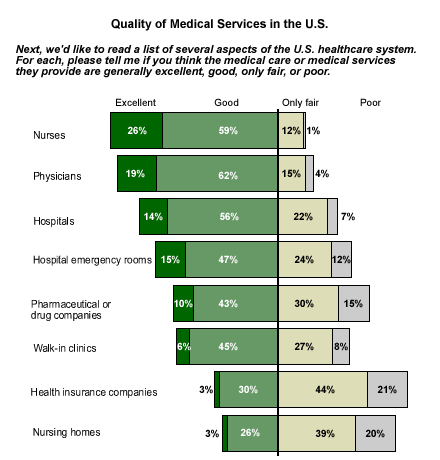With the recent passage of the long-debated Medicare bill, the quality of healthcare in the United States has been a topic of endless discussion -- on television, in the newspaper, and around the dinner table. But the system is so massive and multifaceted that the phrase "healthcare quality" can mean many things to different people. It encompasses the places we go for healthcare treatment, the people who administer care, and the companies who provide our medications. How do these specific institutions and professions measure up in the eyes of Americans? Gallup's November 2003 Health and Healthcare survey* sought to find out.
The survey presented respondents with eight different elements of the U.S. healthcare system and asked them to rate "the medical care or medical services" that each one provides as "excellent," "good," "only fair," or "poor."

Nurses and Doctors
The U.S. population seems to identify most with the people in the U.S. healthcare system, rather than the institutions. Nurses and physicians receive the most positive rankings on the services they provide (85% rate nurses as excellent or good), and 81% rate physicians as excellent or good. These ratings aren't surprising, given the fact that both professions consistently score at the top of the list in Gallup's annual Honesty and Ethics poll. But although these ratings are positive, there is room for improvement -- only 26% of Americans rate nurses as excellent and only 19% do so for physicians.
Hospitals, ERs and Walk-in Clinics
Despite recent studies showing longer waits and increased overcrowding of hospital emergency rooms (see "ER Dilemma: Patients Must Take a Number" in Related Items), this survey shows that a majority of Americans still rate the country's emergency rooms positively. Sixty-two percent say they think emergency room care is excellent or good, just eight percentage points behind hospitals overall -- they receive a 70% positive rating. Emergency rooms also outperform walk-in clinics (often seen as a more convenient alternative to the emergency room), which receive a 51% positive rating.
Health Insurance Companies, Nursing Homes, and Drug Companies
Health insurance companies and nursing homes are at the opposite end of the spectrum from nurses and doctors. Sixty-five percent of respondents rated health insurance companies as only fair (44%) or poor (21%), and 59% gave only fair (39%) or poor (20%) ratings to nursing homes. Only 33% rated health insurance companies as excellent or good, and just 29% gave positive ratings to nursing homes. Clearly, these two institutions are detracting from Americans' favorable impression of healthcare in the United States.
Americans are fairly evenly divided in their ratings of pharmaceutical/drug companies, which have played a large role in the debate about prescription drug coverage for Medicare recipients. Fifty-three percent of Americans rate drug companies positively, while 45% rate them negatively.
Implications
Aging baby boomers and seniors form a powerful political constituency. To appeal to this group, Congress has passed a Medicare bill that includes an experiment in incorporating private health insurance competition. But health insurance companies receive the highest negative rating of the eight items measured here -- if they are going to provide an acceptable alternative to Medicare in the eyes of Americans, their quality of service must improve.
Older Americans are also affected by another negatively rated element of the healthcare system: nursing homes, which are rated positively by only 31% of people over the age of 50. Nursing home beds are already in short supply, and the baby boomer bubble will exacerbate this shortage over the next few decades.
One positive aspect of these ratings is the high regard Americans hold for doctors and nurses. High ratings of nurses are especially encouraging because the country is experiencing a severe shortage. But the question remains: How much more acute can these shortages become before they begin to negatively impact public perceptions of nursing quality?
*Results are based on telephone interviews with 1,007 national adults, aged 18 and older, conducted Nov. 3-5, 2003. For results based on the total sample of national adults, one can say with 95% confidence that the margin of sampling error is ±3 percentage points.
